HI6028 Taxation Law: Capital Gains and Income Assessment Analysis
VerifiedAdded on 2023/03/30
|10
|1953
|215
Homework Assignment
AI Summary
This assignment solution delves into various aspects of Australian taxation law, focusing on capital gains and income assessment. It analyzes scenarios involving the sale of antique paintings, historical structures, and jewelry to determine capital gains tax implications, referencing relevant sections of the Income Tax Assessment Act 1997. Furthermore, it examines whether receipts constitute income from personal exertion, considering factors such as intention to profit and the nature of the services provided. The solution also addresses the assessability of interest payments on loans, applying relevant case law such as FC of T v Whitfords Beach Pty Ltd. Desklib provides this and many other assignment solutions for students.
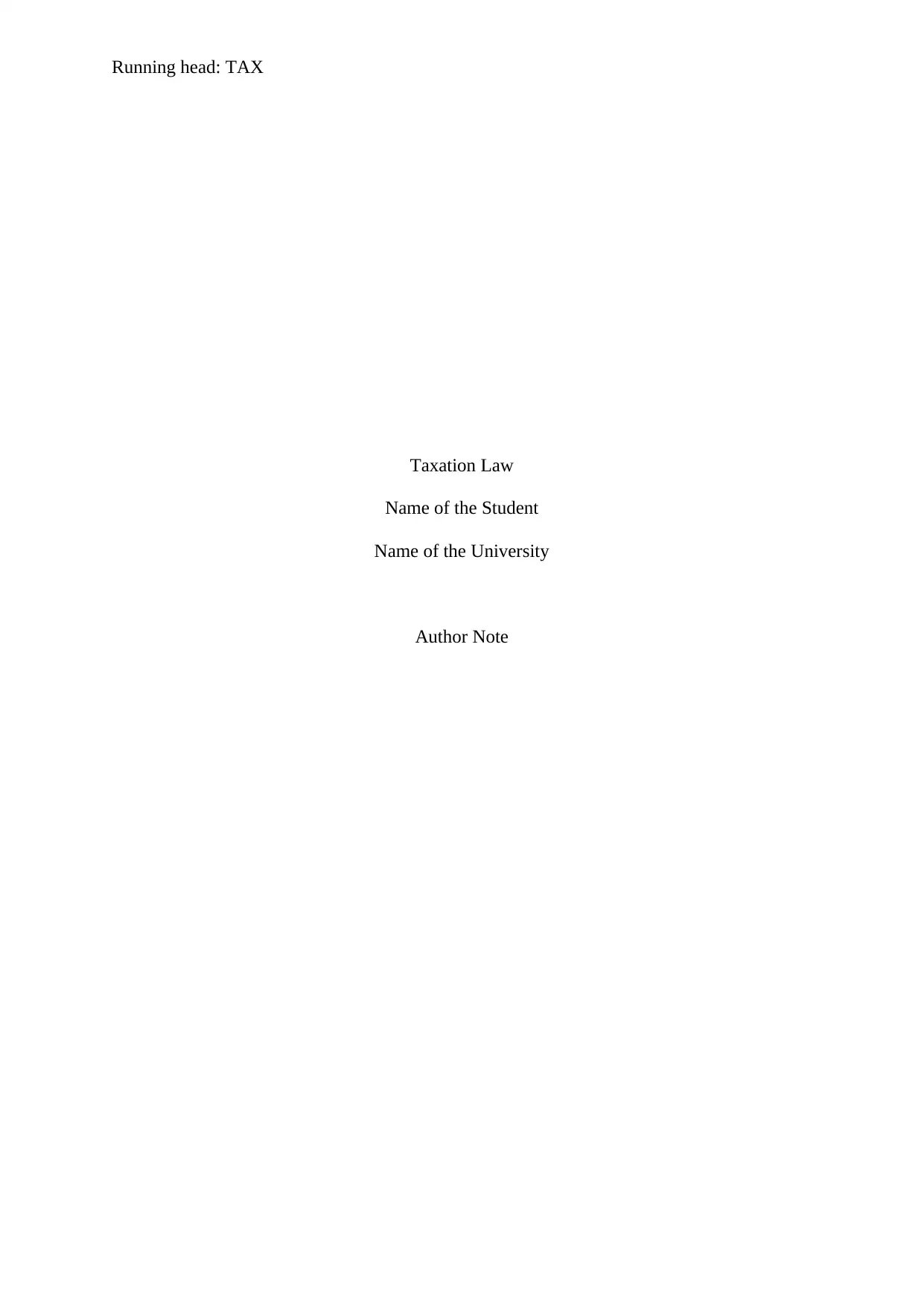
Running head: TAX
Taxation Law
Name of the Student
Name of the University
Author Note
Taxation Law
Name of the Student
Name of the University
Author Note
Paraphrase This Document
Need a fresh take? Get an instant paraphrase of this document with our AI Paraphraser
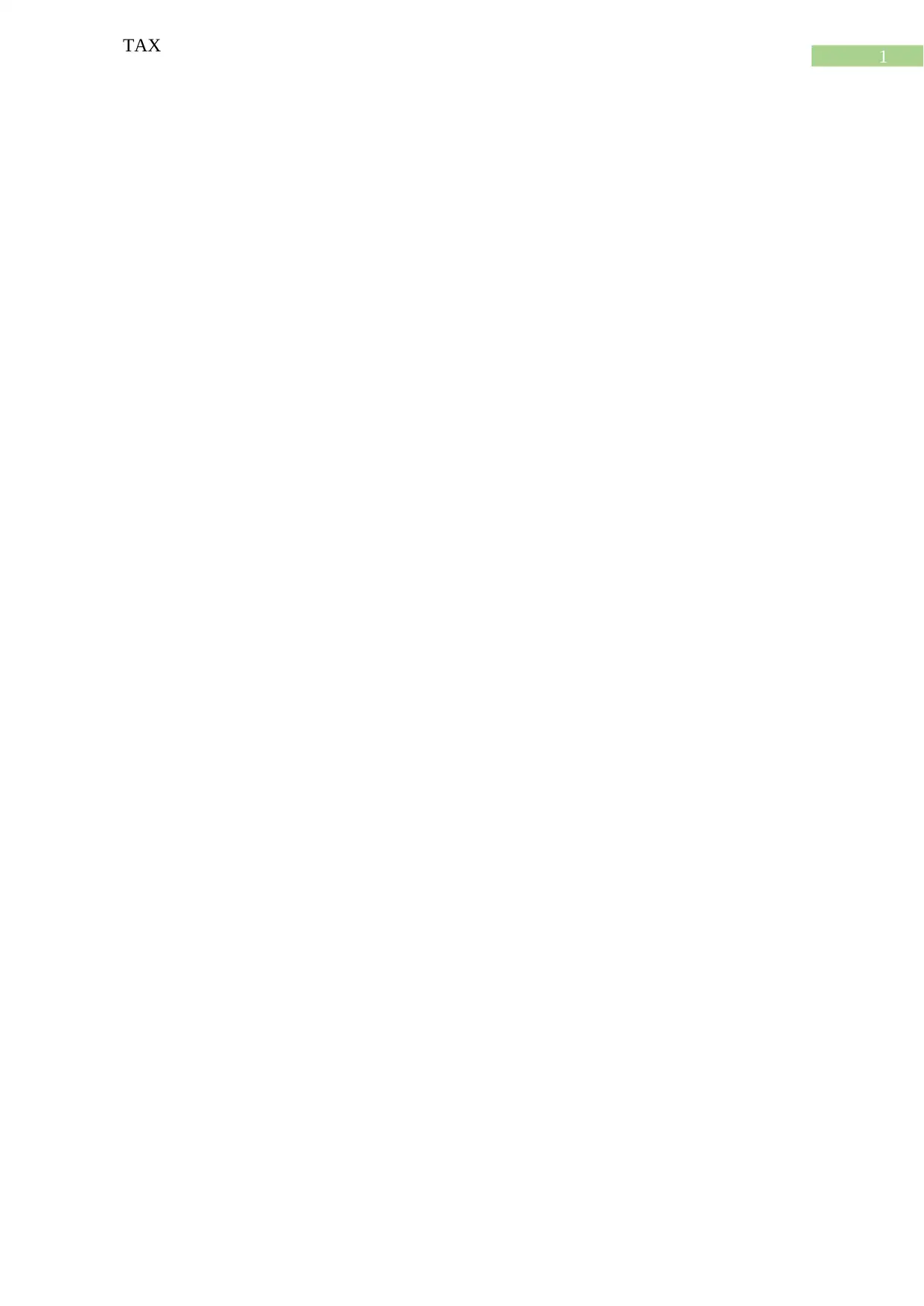
1
TAX
TAX
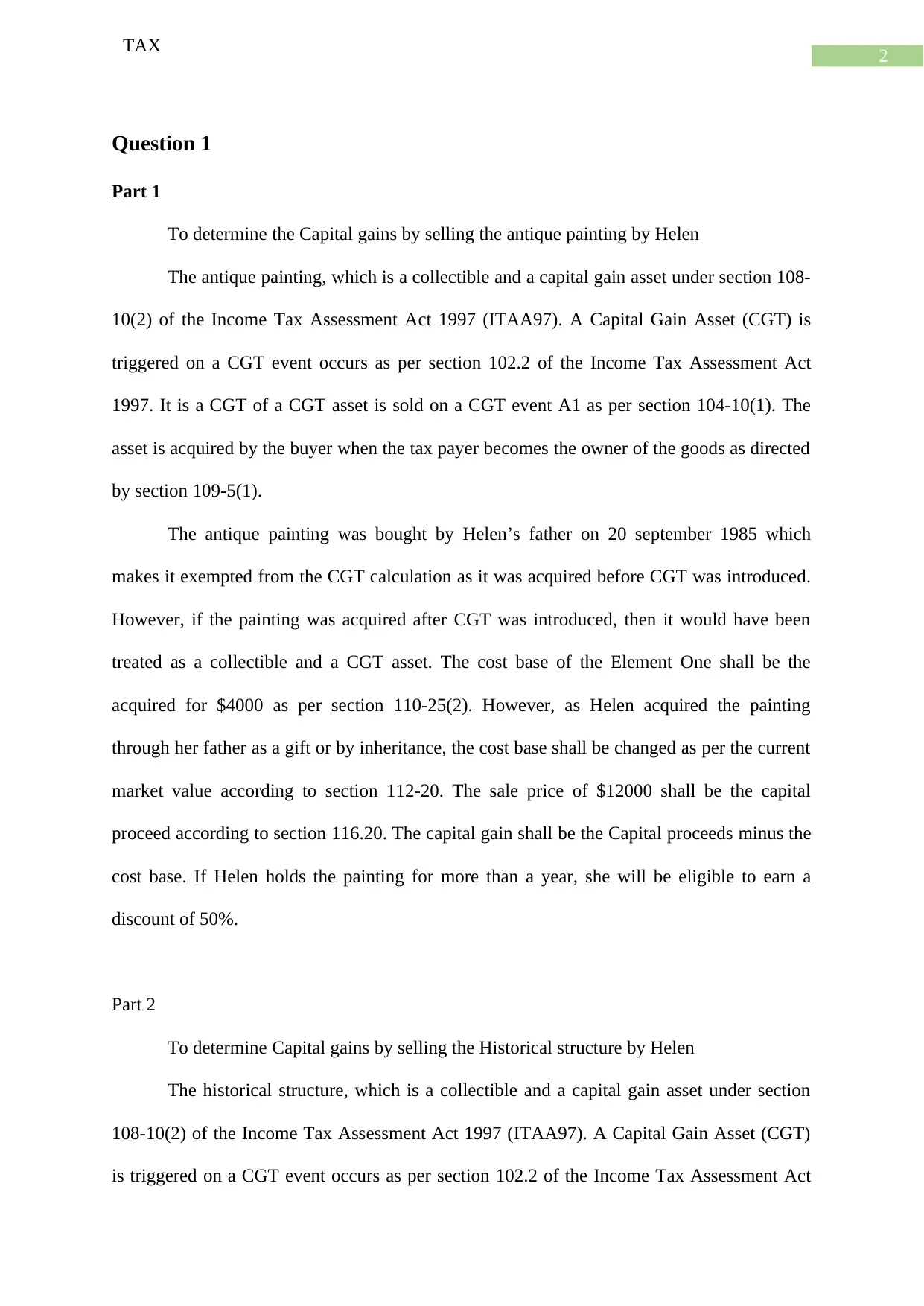
2
TAX
Question 1
Part 1
To determine the Capital gains by selling the antique painting by Helen
The antique painting, which is a collectible and a capital gain asset under section 108-
10(2) of the Income Tax Assessment Act 1997 (ITAA97). A Capital Gain Asset (CGT) is
triggered on a CGT event occurs as per section 102.2 of the Income Tax Assessment Act
1997. It is a CGT of a CGT asset is sold on a CGT event A1 as per section 104-10(1). The
asset is acquired by the buyer when the tax payer becomes the owner of the goods as directed
by section 109-5(1).
The antique painting was bought by Helen’s father on 20 september 1985 which
makes it exempted from the CGT calculation as it was acquired before CGT was introduced.
However, if the painting was acquired after CGT was introduced, then it would have been
treated as a collectible and a CGT asset. The cost base of the Element One shall be the
acquired for $4000 as per section 110-25(2). However, as Helen acquired the painting
through her father as a gift or by inheritance, the cost base shall be changed as per the current
market value according to section 112-20. The sale price of $12000 shall be the capital
proceed according to section 116.20. The capital gain shall be the Capital proceeds minus the
cost base. If Helen holds the painting for more than a year, she will be eligible to earn a
discount of 50%.
Part 2
To determine Capital gains by selling the Historical structure by Helen
The historical structure, which is a collectible and a capital gain asset under section
108-10(2) of the Income Tax Assessment Act 1997 (ITAA97). A Capital Gain Asset (CGT)
is triggered on a CGT event occurs as per section 102.2 of the Income Tax Assessment Act
TAX
Question 1
Part 1
To determine the Capital gains by selling the antique painting by Helen
The antique painting, which is a collectible and a capital gain asset under section 108-
10(2) of the Income Tax Assessment Act 1997 (ITAA97). A Capital Gain Asset (CGT) is
triggered on a CGT event occurs as per section 102.2 of the Income Tax Assessment Act
1997. It is a CGT of a CGT asset is sold on a CGT event A1 as per section 104-10(1). The
asset is acquired by the buyer when the tax payer becomes the owner of the goods as directed
by section 109-5(1).
The antique painting was bought by Helen’s father on 20 september 1985 which
makes it exempted from the CGT calculation as it was acquired before CGT was introduced.
However, if the painting was acquired after CGT was introduced, then it would have been
treated as a collectible and a CGT asset. The cost base of the Element One shall be the
acquired for $4000 as per section 110-25(2). However, as Helen acquired the painting
through her father as a gift or by inheritance, the cost base shall be changed as per the current
market value according to section 112-20. The sale price of $12000 shall be the capital
proceed according to section 116.20. The capital gain shall be the Capital proceeds minus the
cost base. If Helen holds the painting for more than a year, she will be eligible to earn a
discount of 50%.
Part 2
To determine Capital gains by selling the Historical structure by Helen
The historical structure, which is a collectible and a capital gain asset under section
108-10(2) of the Income Tax Assessment Act 1997 (ITAA97). A Capital Gain Asset (CGT)
is triggered on a CGT event occurs as per section 102.2 of the Income Tax Assessment Act
⊘ This is a preview!⊘
Do you want full access?
Subscribe today to unlock all pages.

Trusted by 1+ million students worldwide
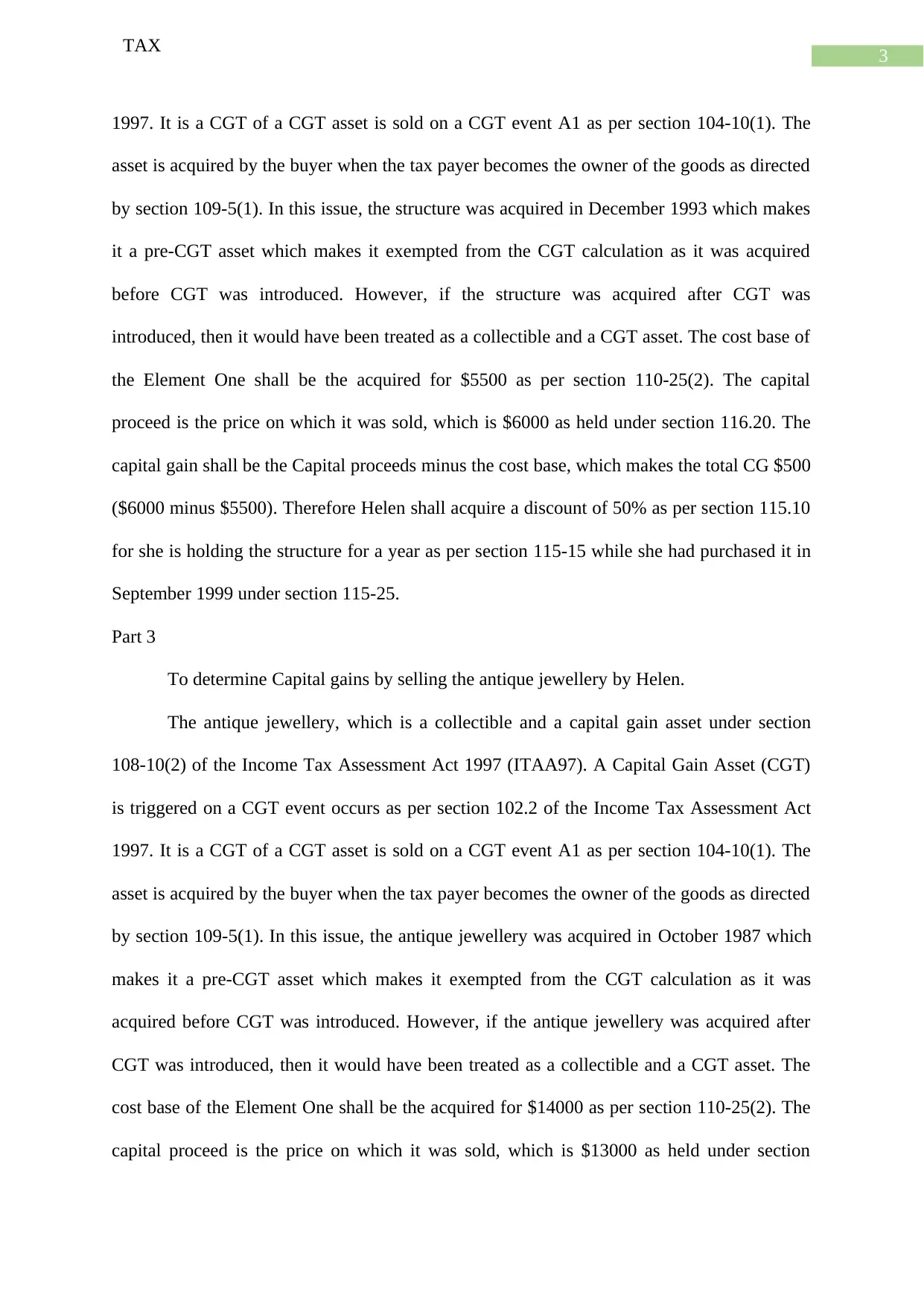
3
TAX
1997. It is a CGT of a CGT asset is sold on a CGT event A1 as per section 104-10(1). The
asset is acquired by the buyer when the tax payer becomes the owner of the goods as directed
by section 109-5(1). In this issue, the structure was acquired in December 1993 which makes
it a pre-CGT asset which makes it exempted from the CGT calculation as it was acquired
before CGT was introduced. However, if the structure was acquired after CGT was
introduced, then it would have been treated as a collectible and a CGT asset. The cost base of
the Element One shall be the acquired for $5500 as per section 110-25(2). The capital
proceed is the price on which it was sold, which is $6000 as held under section 116.20. The
capital gain shall be the Capital proceeds minus the cost base, which makes the total CG $500
($6000 minus $5500). Therefore Helen shall acquire a discount of 50% as per section 115.10
for she is holding the structure for a year as per section 115-15 while she had purchased it in
September 1999 under section 115-25.
Part 3
To determine Capital gains by selling the antique jewellery by Helen.
The antique jewellery, which is a collectible and a capital gain asset under section
108-10(2) of the Income Tax Assessment Act 1997 (ITAA97). A Capital Gain Asset (CGT)
is triggered on a CGT event occurs as per section 102.2 of the Income Tax Assessment Act
1997. It is a CGT of a CGT asset is sold on a CGT event A1 as per section 104-10(1). The
asset is acquired by the buyer when the tax payer becomes the owner of the goods as directed
by section 109-5(1). In this issue, the antique jewellery was acquired in October 1987 which
makes it a pre-CGT asset which makes it exempted from the CGT calculation as it was
acquired before CGT was introduced. However, if the antique jewellery was acquired after
CGT was introduced, then it would have been treated as a collectible and a CGT asset. The
cost base of the Element One shall be the acquired for $14000 as per section 110-25(2). The
capital proceed is the price on which it was sold, which is $13000 as held under section
TAX
1997. It is a CGT of a CGT asset is sold on a CGT event A1 as per section 104-10(1). The
asset is acquired by the buyer when the tax payer becomes the owner of the goods as directed
by section 109-5(1). In this issue, the structure was acquired in December 1993 which makes
it a pre-CGT asset which makes it exempted from the CGT calculation as it was acquired
before CGT was introduced. However, if the structure was acquired after CGT was
introduced, then it would have been treated as a collectible and a CGT asset. The cost base of
the Element One shall be the acquired for $5500 as per section 110-25(2). The capital
proceed is the price on which it was sold, which is $6000 as held under section 116.20. The
capital gain shall be the Capital proceeds minus the cost base, which makes the total CG $500
($6000 minus $5500). Therefore Helen shall acquire a discount of 50% as per section 115.10
for she is holding the structure for a year as per section 115-15 while she had purchased it in
September 1999 under section 115-25.
Part 3
To determine Capital gains by selling the antique jewellery by Helen.
The antique jewellery, which is a collectible and a capital gain asset under section
108-10(2) of the Income Tax Assessment Act 1997 (ITAA97). A Capital Gain Asset (CGT)
is triggered on a CGT event occurs as per section 102.2 of the Income Tax Assessment Act
1997. It is a CGT of a CGT asset is sold on a CGT event A1 as per section 104-10(1). The
asset is acquired by the buyer when the tax payer becomes the owner of the goods as directed
by section 109-5(1). In this issue, the antique jewellery was acquired in October 1987 which
makes it a pre-CGT asset which makes it exempted from the CGT calculation as it was
acquired before CGT was introduced. However, if the antique jewellery was acquired after
CGT was introduced, then it would have been treated as a collectible and a CGT asset. The
cost base of the Element One shall be the acquired for $14000 as per section 110-25(2). The
capital proceed is the price on which it was sold, which is $13000 as held under section
Paraphrase This Document
Need a fresh take? Get an instant paraphrase of this document with our AI Paraphraser
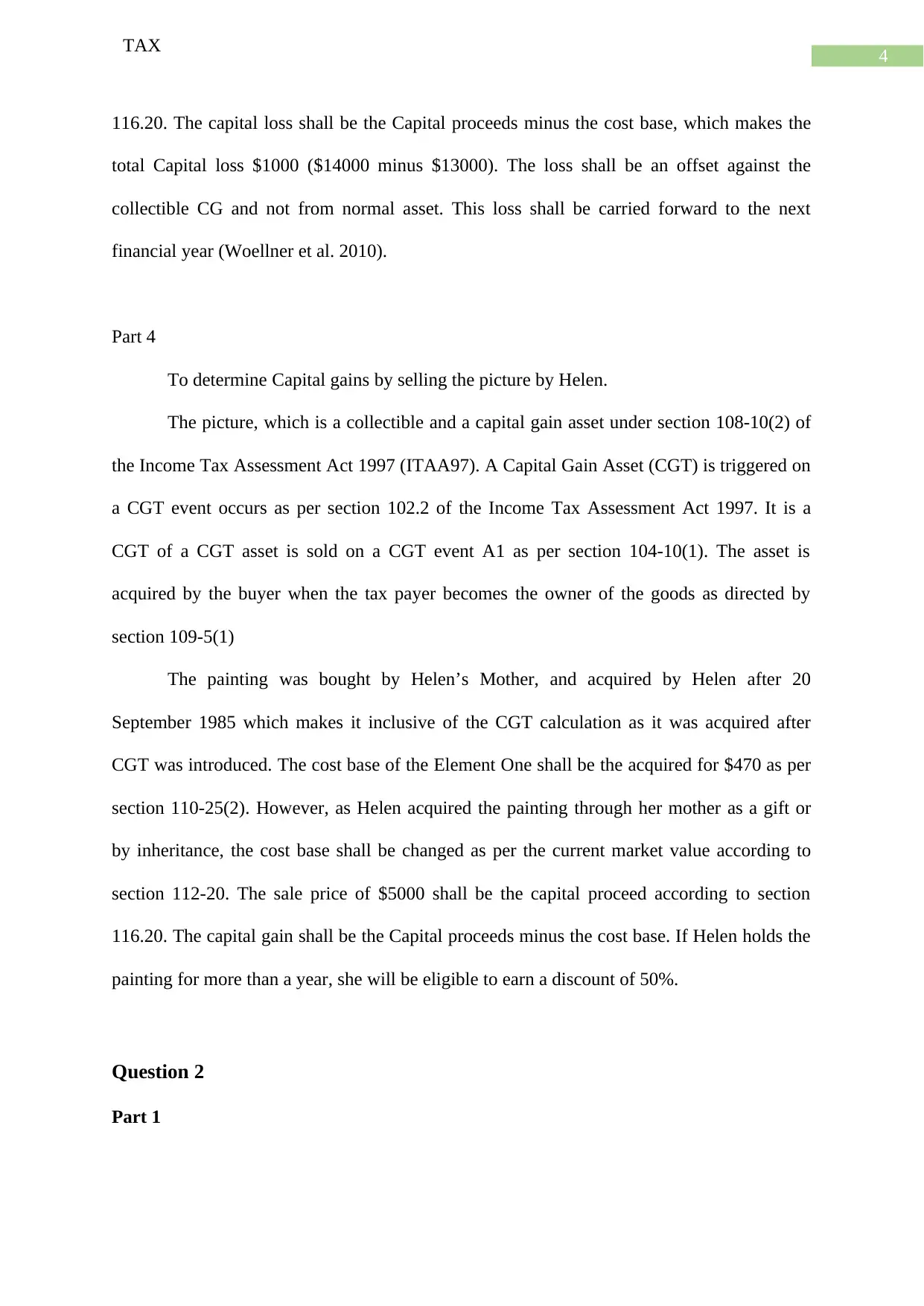
4
TAX
116.20. The capital loss shall be the Capital proceeds minus the cost base, which makes the
total Capital loss $1000 ($14000 minus $13000). The loss shall be an offset against the
collectible CG and not from normal asset. This loss shall be carried forward to the next
financial year (Woellner et al. 2010).
Part 4
To determine Capital gains by selling the picture by Helen.
The picture, which is a collectible and a capital gain asset under section 108-10(2) of
the Income Tax Assessment Act 1997 (ITAA97). A Capital Gain Asset (CGT) is triggered on
a CGT event occurs as per section 102.2 of the Income Tax Assessment Act 1997. It is a
CGT of a CGT asset is sold on a CGT event A1 as per section 104-10(1). The asset is
acquired by the buyer when the tax payer becomes the owner of the goods as directed by
section 109-5(1)
The painting was bought by Helen’s Mother, and acquired by Helen after 20
September 1985 which makes it inclusive of the CGT calculation as it was acquired after
CGT was introduced. The cost base of the Element One shall be the acquired for $470 as per
section 110-25(2). However, as Helen acquired the painting through her mother as a gift or
by inheritance, the cost base shall be changed as per the current market value according to
section 112-20. The sale price of $5000 shall be the capital proceed according to section
116.20. The capital gain shall be the Capital proceeds minus the cost base. If Helen holds the
painting for more than a year, she will be eligible to earn a discount of 50%.
Question 2
Part 1
TAX
116.20. The capital loss shall be the Capital proceeds minus the cost base, which makes the
total Capital loss $1000 ($14000 minus $13000). The loss shall be an offset against the
collectible CG and not from normal asset. This loss shall be carried forward to the next
financial year (Woellner et al. 2010).
Part 4
To determine Capital gains by selling the picture by Helen.
The picture, which is a collectible and a capital gain asset under section 108-10(2) of
the Income Tax Assessment Act 1997 (ITAA97). A Capital Gain Asset (CGT) is triggered on
a CGT event occurs as per section 102.2 of the Income Tax Assessment Act 1997. It is a
CGT of a CGT asset is sold on a CGT event A1 as per section 104-10(1). The asset is
acquired by the buyer when the tax payer becomes the owner of the goods as directed by
section 109-5(1)
The painting was bought by Helen’s Mother, and acquired by Helen after 20
September 1985 which makes it inclusive of the CGT calculation as it was acquired after
CGT was introduced. The cost base of the Element One shall be the acquired for $470 as per
section 110-25(2). However, as Helen acquired the painting through her mother as a gift or
by inheritance, the cost base shall be changed as per the current market value according to
section 112-20. The sale price of $5000 shall be the capital proceed according to section
116.20. The capital gain shall be the Capital proceeds minus the cost base. If Helen holds the
painting for more than a year, she will be eligible to earn a discount of 50%.
Question 2
Part 1
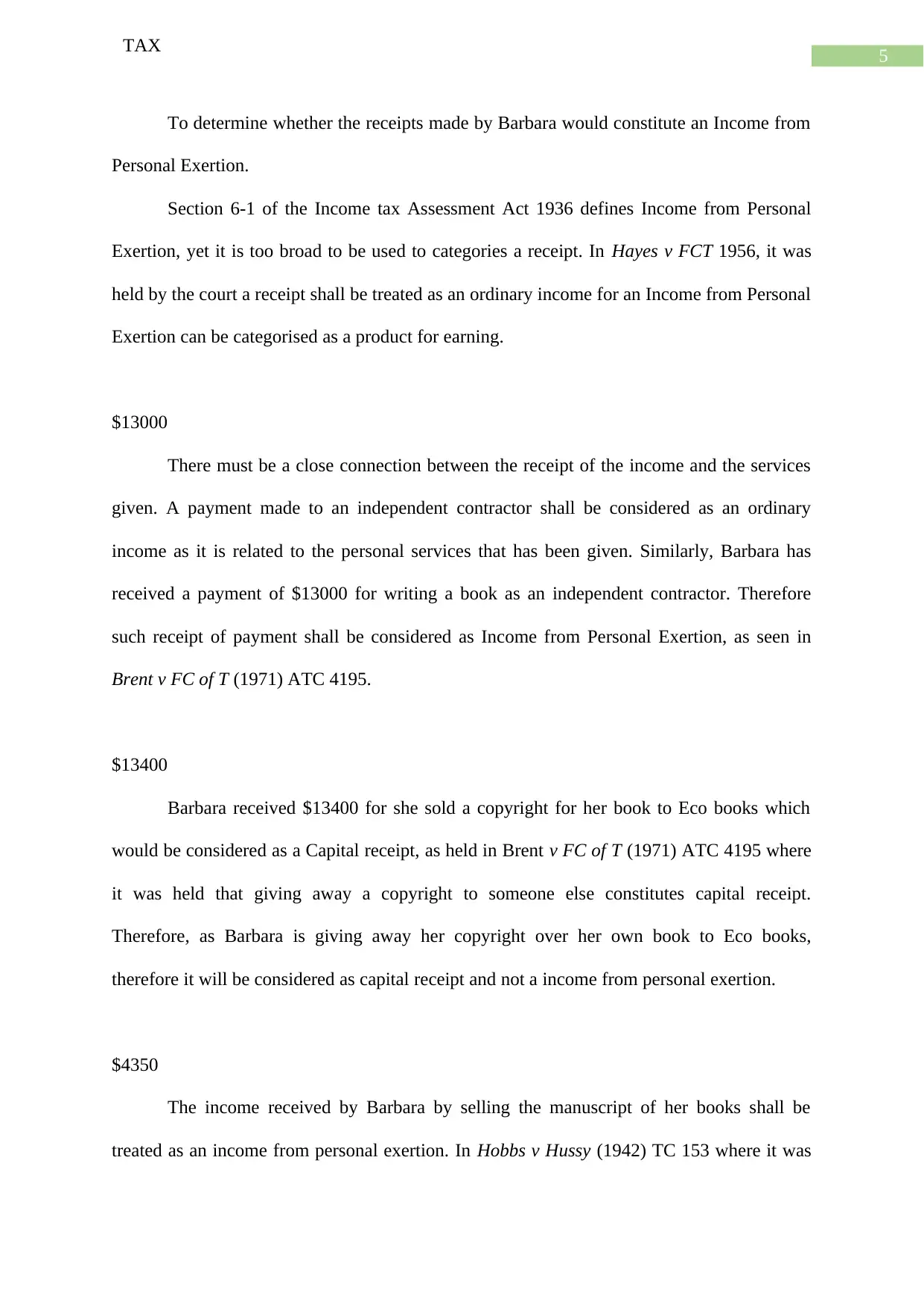
5
TAX
To determine whether the receipts made by Barbara would constitute an Income from
Personal Exertion.
Section 6-1 of the Income tax Assessment Act 1936 defines Income from Personal
Exertion, yet it is too broad to be used to categories a receipt. In Hayes v FCT 1956, it was
held by the court a receipt shall be treated as an ordinary income for an Income from Personal
Exertion can be categorised as a product for earning.
$13000
There must be a close connection between the receipt of the income and the services
given. A payment made to an independent contractor shall be considered as an ordinary
income as it is related to the personal services that has been given. Similarly, Barbara has
received a payment of $13000 for writing a book as an independent contractor. Therefore
such receipt of payment shall be considered as Income from Personal Exertion, as seen in
Brent v FC of T (1971) ATC 4195.
$13400
Barbara received $13400 for she sold a copyright for her book to Eco books which
would be considered as a Capital receipt, as held in Brent v FC of T (1971) ATC 4195 where
it was held that giving away a copyright to someone else constitutes capital receipt.
Therefore, as Barbara is giving away her copyright over her own book to Eco books,
therefore it will be considered as capital receipt and not a income from personal exertion.
$4350
The income received by Barbara by selling the manuscript of her books shall be
treated as an income from personal exertion. In Hobbs v Hussy (1942) TC 153 where it was
TAX
To determine whether the receipts made by Barbara would constitute an Income from
Personal Exertion.
Section 6-1 of the Income tax Assessment Act 1936 defines Income from Personal
Exertion, yet it is too broad to be used to categories a receipt. In Hayes v FCT 1956, it was
held by the court a receipt shall be treated as an ordinary income for an Income from Personal
Exertion can be categorised as a product for earning.
$13000
There must be a close connection between the receipt of the income and the services
given. A payment made to an independent contractor shall be considered as an ordinary
income as it is related to the personal services that has been given. Similarly, Barbara has
received a payment of $13000 for writing a book as an independent contractor. Therefore
such receipt of payment shall be considered as Income from Personal Exertion, as seen in
Brent v FC of T (1971) ATC 4195.
$13400
Barbara received $13400 for she sold a copyright for her book to Eco books which
would be considered as a Capital receipt, as held in Brent v FC of T (1971) ATC 4195 where
it was held that giving away a copyright to someone else constitutes capital receipt.
Therefore, as Barbara is giving away her copyright over her own book to Eco books,
therefore it will be considered as capital receipt and not a income from personal exertion.
$4350
The income received by Barbara by selling the manuscript of her books shall be
treated as an income from personal exertion. In Hobbs v Hussy (1942) TC 153 where it was
⊘ This is a preview!⊘
Do you want full access?
Subscribe today to unlock all pages.

Trusted by 1+ million students worldwide
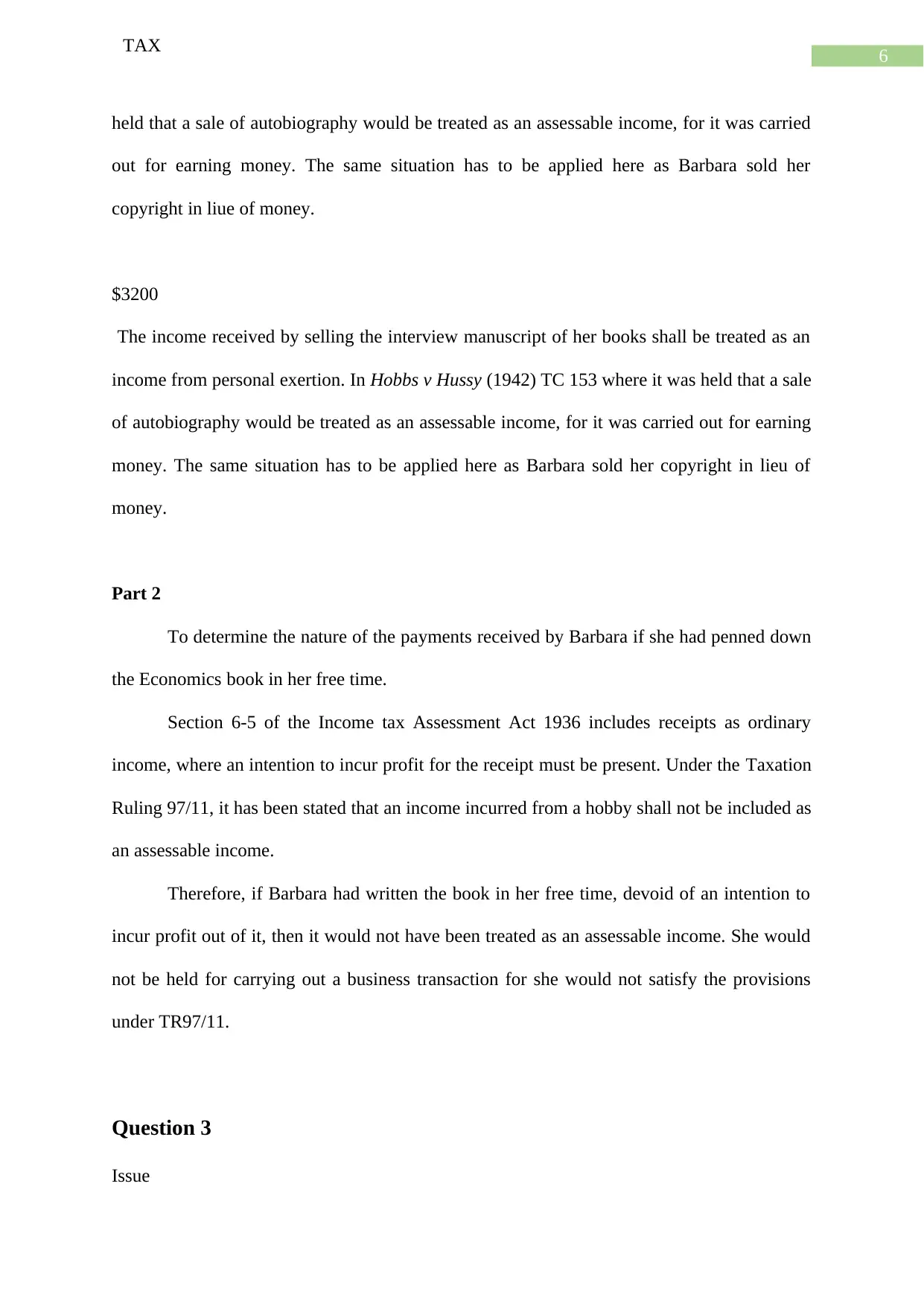
6
TAX
held that a sale of autobiography would be treated as an assessable income, for it was carried
out for earning money. The same situation has to be applied here as Barbara sold her
copyright in liue of money.
$3200
The income received by selling the interview manuscript of her books shall be treated as an
income from personal exertion. In Hobbs v Hussy (1942) TC 153 where it was held that a sale
of autobiography would be treated as an assessable income, for it was carried out for earning
money. The same situation has to be applied here as Barbara sold her copyright in lieu of
money.
Part 2
To determine the nature of the payments received by Barbara if she had penned down
the Economics book in her free time.
Section 6-5 of the Income tax Assessment Act 1936 includes receipts as ordinary
income, where an intention to incur profit for the receipt must be present. Under the Taxation
Ruling 97/11, it has been stated that an income incurred from a hobby shall not be included as
an assessable income.
Therefore, if Barbara had written the book in her free time, devoid of an intention to
incur profit out of it, then it would not have been treated as an assessable income. She would
not be held for carrying out a business transaction for she would not satisfy the provisions
under TR97/11.
Question 3
Issue
TAX
held that a sale of autobiography would be treated as an assessable income, for it was carried
out for earning money. The same situation has to be applied here as Barbara sold her
copyright in liue of money.
$3200
The income received by selling the interview manuscript of her books shall be treated as an
income from personal exertion. In Hobbs v Hussy (1942) TC 153 where it was held that a sale
of autobiography would be treated as an assessable income, for it was carried out for earning
money. The same situation has to be applied here as Barbara sold her copyright in lieu of
money.
Part 2
To determine the nature of the payments received by Barbara if she had penned down
the Economics book in her free time.
Section 6-5 of the Income tax Assessment Act 1936 includes receipts as ordinary
income, where an intention to incur profit for the receipt must be present. Under the Taxation
Ruling 97/11, it has been stated that an income incurred from a hobby shall not be included as
an assessable income.
Therefore, if Barbara had written the book in her free time, devoid of an intention to
incur profit out of it, then it would not have been treated as an assessable income. She would
not be held for carrying out a business transaction for she would not satisfy the provisions
under TR97/11.
Question 3
Issue
Paraphrase This Document
Need a fresh take? Get an instant paraphrase of this document with our AI Paraphraser
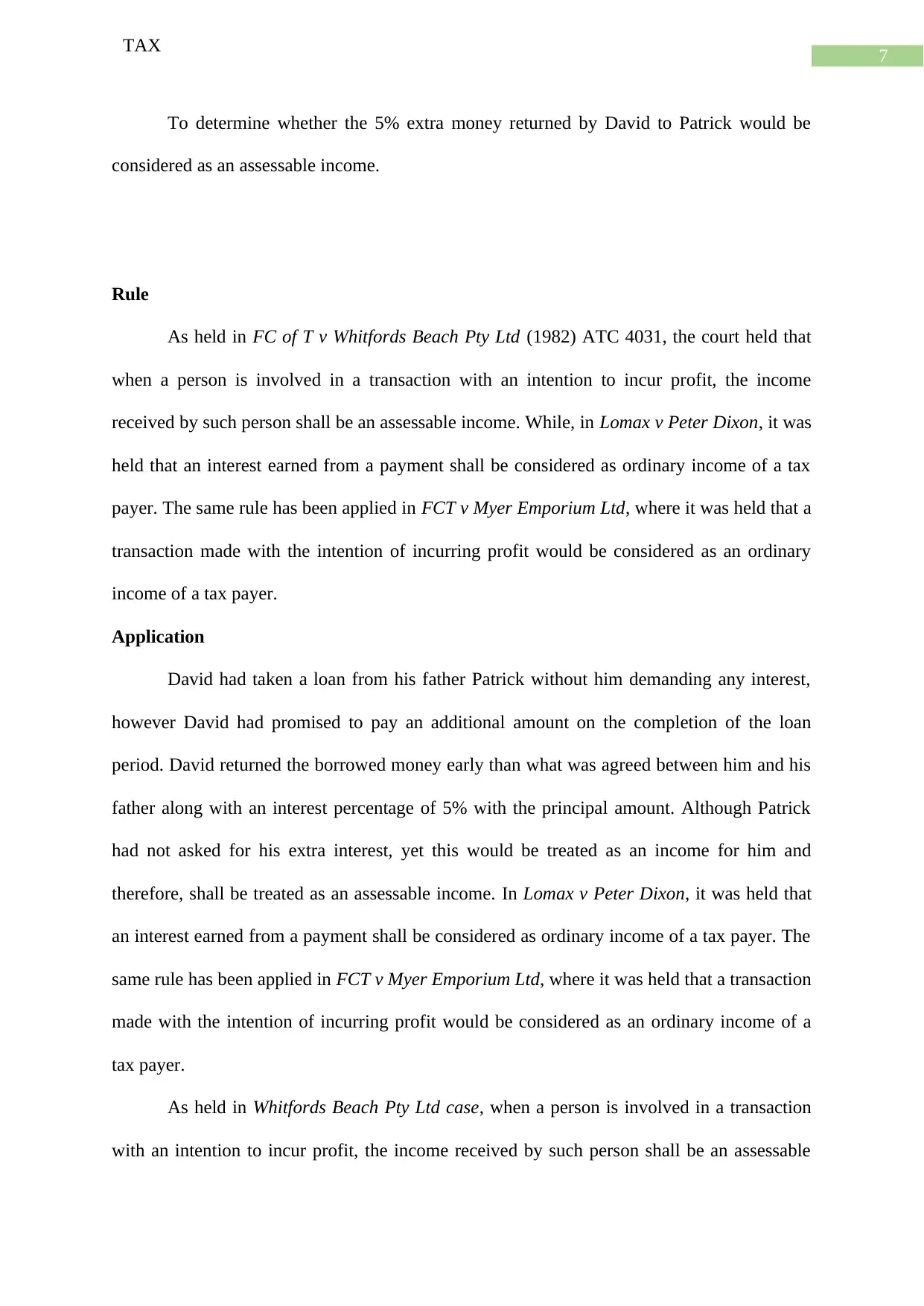
7
TAX
To determine whether the 5% extra money returned by David to Patrick would be
considered as an assessable income.
Rule
As held in FC of T v Whitfords Beach Pty Ltd (1982) ATC 4031, the court held that
when a person is involved in a transaction with an intention to incur profit, the income
received by such person shall be an assessable income. While, in Lomax v Peter Dixon, it was
held that an interest earned from a payment shall be considered as ordinary income of a tax
payer. The same rule has been applied in FCT v Myer Emporium Ltd, where it was held that a
transaction made with the intention of incurring profit would be considered as an ordinary
income of a tax payer.
Application
David had taken a loan from his father Patrick without him demanding any interest,
however David had promised to pay an additional amount on the completion of the loan
period. David returned the borrowed money early than what was agreed between him and his
father along with an interest percentage of 5% with the principal amount. Although Patrick
had not asked for his extra interest, yet this would be treated as an income for him and
therefore, shall be treated as an assessable income. In Lomax v Peter Dixon, it was held that
an interest earned from a payment shall be considered as ordinary income of a tax payer. The
same rule has been applied in FCT v Myer Emporium Ltd, where it was held that a transaction
made with the intention of incurring profit would be considered as an ordinary income of a
tax payer.
As held in Whitfords Beach Pty Ltd case, when a person is involved in a transaction
with an intention to incur profit, the income received by such person shall be an assessable
TAX
To determine whether the 5% extra money returned by David to Patrick would be
considered as an assessable income.
Rule
As held in FC of T v Whitfords Beach Pty Ltd (1982) ATC 4031, the court held that
when a person is involved in a transaction with an intention to incur profit, the income
received by such person shall be an assessable income. While, in Lomax v Peter Dixon, it was
held that an interest earned from a payment shall be considered as ordinary income of a tax
payer. The same rule has been applied in FCT v Myer Emporium Ltd, where it was held that a
transaction made with the intention of incurring profit would be considered as an ordinary
income of a tax payer.
Application
David had taken a loan from his father Patrick without him demanding any interest,
however David had promised to pay an additional amount on the completion of the loan
period. David returned the borrowed money early than what was agreed between him and his
father along with an interest percentage of 5% with the principal amount. Although Patrick
had not asked for his extra interest, yet this would be treated as an income for him and
therefore, shall be treated as an assessable income. In Lomax v Peter Dixon, it was held that
an interest earned from a payment shall be considered as ordinary income of a tax payer. The
same rule has been applied in FCT v Myer Emporium Ltd, where it was held that a transaction
made with the intention of incurring profit would be considered as an ordinary income of a
tax payer.
As held in Whitfords Beach Pty Ltd case, when a person is involved in a transaction
with an intention to incur profit, the income received by such person shall be an assessable
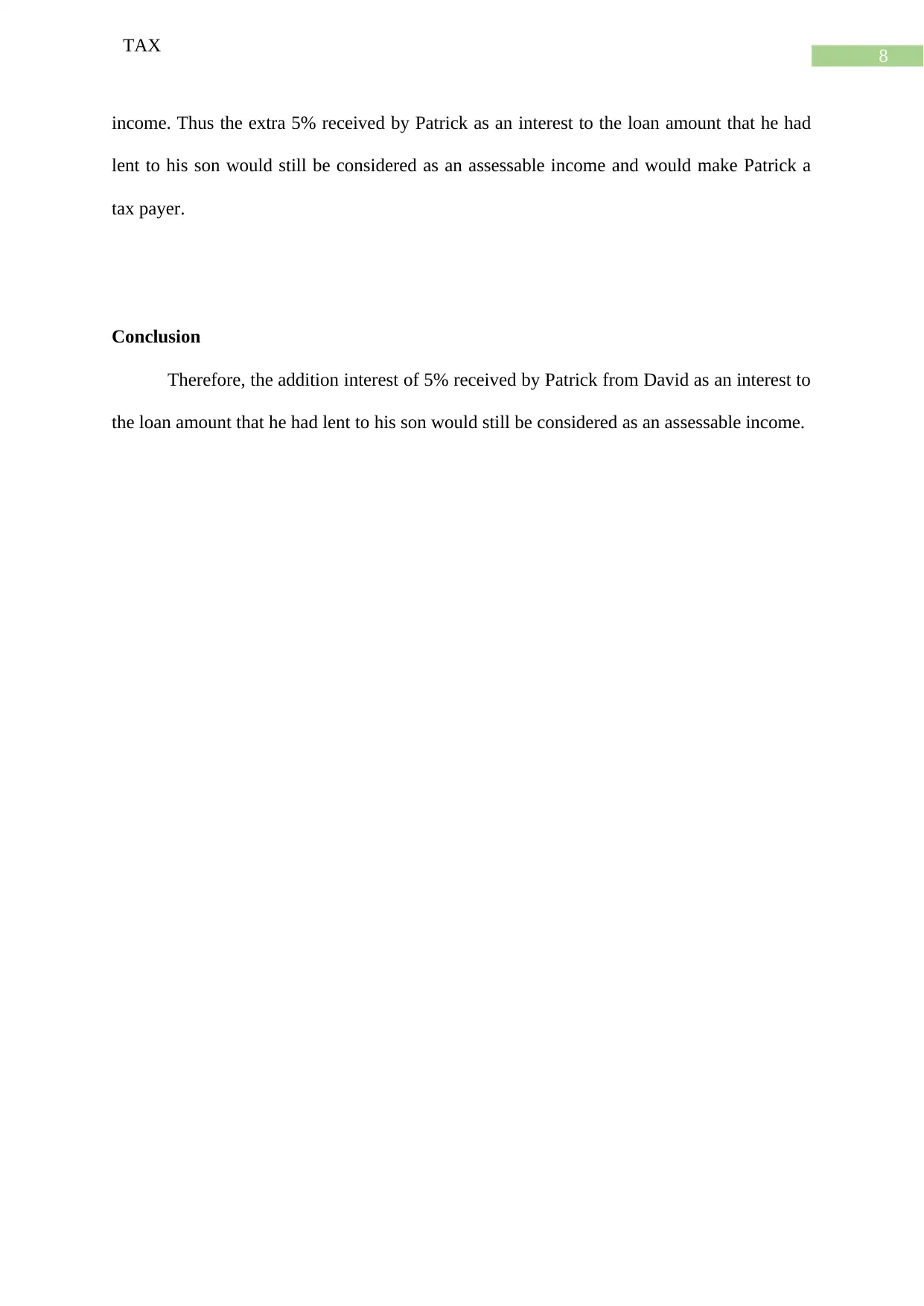
8
TAX
income. Thus the extra 5% received by Patrick as an interest to the loan amount that he had
lent to his son would still be considered as an assessable income and would make Patrick a
tax payer.
Conclusion
Therefore, the addition interest of 5% received by Patrick from David as an interest to
the loan amount that he had lent to his son would still be considered as an assessable income.
TAX
income. Thus the extra 5% received by Patrick as an interest to the loan amount that he had
lent to his son would still be considered as an assessable income and would make Patrick a
tax payer.
Conclusion
Therefore, the addition interest of 5% received by Patrick from David as an interest to
the loan amount that he had lent to his son would still be considered as an assessable income.
⊘ This is a preview!⊘
Do you want full access?
Subscribe today to unlock all pages.

Trusted by 1+ million students worldwide
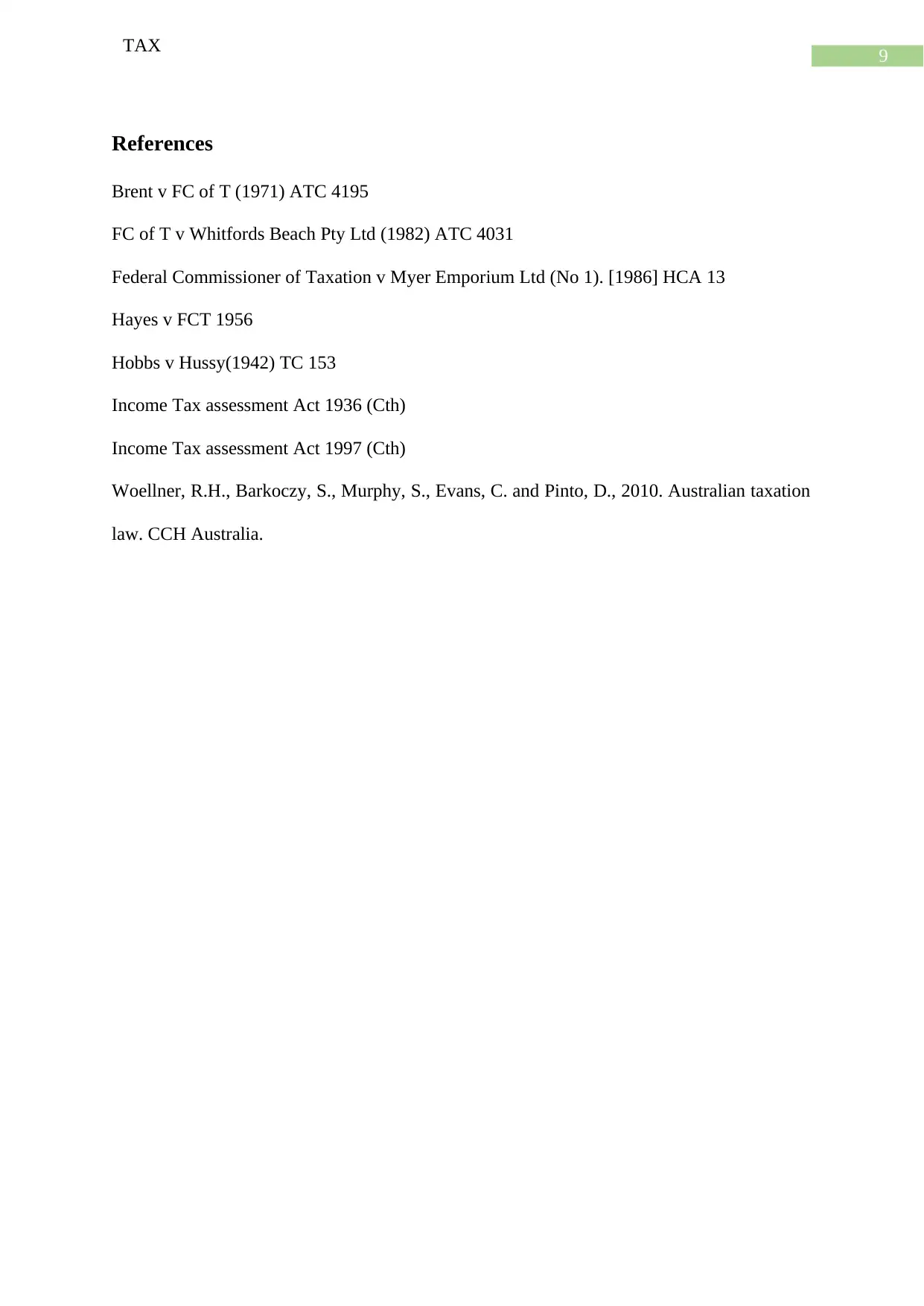
9
TAX
References
Brent v FC of T (1971) ATC 4195
FC of T v Whitfords Beach Pty Ltd (1982) ATC 4031
Federal Commissioner of Taxation v Myer Emporium Ltd (No 1). [1986] HCA 13
Hayes v FCT 1956
Hobbs v Hussy(1942) TC 153
Income Tax assessment Act 1936 (Cth)
Income Tax assessment Act 1997 (Cth)
Woellner, R.H., Barkoczy, S., Murphy, S., Evans, C. and Pinto, D., 2010. Australian taxation
law. CCH Australia.
TAX
References
Brent v FC of T (1971) ATC 4195
FC of T v Whitfords Beach Pty Ltd (1982) ATC 4031
Federal Commissioner of Taxation v Myer Emporium Ltd (No 1). [1986] HCA 13
Hayes v FCT 1956
Hobbs v Hussy(1942) TC 153
Income Tax assessment Act 1936 (Cth)
Income Tax assessment Act 1997 (Cth)
Woellner, R.H., Barkoczy, S., Murphy, S., Evans, C. and Pinto, D., 2010. Australian taxation
law. CCH Australia.
1 out of 10
Related Documents
Your All-in-One AI-Powered Toolkit for Academic Success.
+13062052269
info@desklib.com
Available 24*7 on WhatsApp / Email
![[object Object]](/_next/static/media/star-bottom.7253800d.svg)
Unlock your academic potential
Copyright © 2020–2025 A2Z Services. All Rights Reserved. Developed and managed by ZUCOL.





